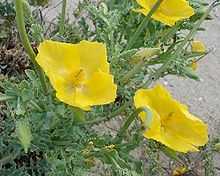Glaucium flavum
| Yellow hornpoppy | |
|---|---|
 | |
| Scientific classification | |
| Kingdom: | Plantae |
| (unranked): | Angiosperms |
| (unranked): | Eudicots |
| Order: | Ranunculales |
| Family: | Papaveraceae |
| Genus: | Glaucium |
| Species: | G. flavum |
| Binomial name | |
| Glaucium flavum Crantz | |
Glaucium flavum (yellow hornpoppy or yellow horned poppy) is a summer flowering plant in the Papaveraceae family, which is native to Northern Africa, Macronesia, temperate zones in Western Asia and the Caucasus, as well as Europe. Habitat: the plant grows on the seashore and is never found inland. All parts of the plant, including the seeds, are toxic and can produce a range of symptoms up to and including respiratory failure resulting in death FDA poisonous plants database.[2] It is a noxious weed in some areas of North America, where it is an introduced species. The thick, leathery deeply segmented, wavy, bluish-grey leaves are coated in a layer of water retaining wax. The sepal, petals and stamen have a similar structure and form to the Red Poppy (Papaver rhoeas) except the sepals are not hairy. Prolific quantities of seeds are held in a distinctive horn shaped fruit some 15 to 30 cm in length, which is divided into two chambers.[3]
In poetry
A poppy grows upon the shore,
- Bursts her twin cups in summer late:
Her leaves are glaucus-green and hoar,
- Her petals yellow, delicate.
She has no lovers like the red,
- That dances with the noble corn:
Her blossoms on the waves are shed,
- Where she stands shivering and forlorn.
- Shorter Poems Robert Bridges
Uses
Glaucine is the main alkaloid component in Glaucium flavum.[4] Glaucine has bronchodilator and antiinflammatory effects, acting as a PDE4 inhibitor and calcium channel blocker,[5] and is used medically as an antitussive in some countries.[6] Glaucine may produce side effects such as sedation, fatigue, and a hallucinogenic effect characterised by colourful visual images,[7][8] and has recently been detected as a recreational drug.[9] For a detailed bibliography on Glaucine and Glaucium flavum see: National Agricultural Library (Glaugium flavum entry)
References
- ↑ Guia do Estudante - Enfermagem Bacharelado
- ↑ Cooper, M. R. & A. W. Johnson. 1998. Poisonous plants and fungi in Britain: animal and human poisoning. (Cooper & Johnson ed2)
- ↑ L. J. F. Brimble (1947). Flowers in Britain. London: Macmillan and Co. p. 54.
- ↑ G.B. Lapa; O.P. Sheichenko; A.G. Serezhechkin and O.N. Tolkachev (August 2004). "HPLC Determination of Glaucine in Yellow Horn Poppy Grass (Glaucium flavum Crantz)". Pharmaceutical Chemistry Journal 38 (1): 441–442. doi:10.1023/B:PHAC.0000048907.58847.c6. ISSN 0091-150X. Retrieved 14 June 2009. "S-(+)-Glaucine (C21H25NO4) is the main alkaloid component in the grass of yellow horn poppy (Glaucium luteum L., syn. Glaucium flavum Crantz) of the Papaveraceae family"
- ↑ Cortijo J, Villagrasa V, Pons R, Berto L, Martí-Cabrera M, Martinez-Losa M, Domenech T, Beleta J, Morcillo EJ. Bronchodilator and anti-inflammatory activities of glaucine: In vitro studies in human airway smooth muscle and polymorphonuclear leukocytes. British Journal of Pharmacology. 1999 Aug;127(7):1641-51. PMID 10455321
- ↑ Rühle KH, Criscuolo D, Dieterich HA, Köhler D, Riedel G. Objective evaluation of dextromethorphan and glaucine as antitussive agents. British Journal of Clinical Pharmacology. 1984 May;17(5):521-4. PMID 6375709
- ↑ Rovinskiĭ VI. A case of hallucinogen-like action of glaucine. (Russian). Klinicheskaia Meditsina (Mosk). 1989 Sep;67(9):107-8. PMID 2586025
- ↑ Rovinskiĭ VI. Acute glaucine syndrome in the physician's practice: the clinical picture and potential danger. (Russian). Klinicheskaia Meditsina (Mosk). 2006;84(11):68-70. PMID 17243616
- ↑ Dargan PI, Button J, Hawkins L, Archer JR, Ovaska H, Lidder S, Ramsey J, Holt DW, Wood DM. Detection of the pharmaceutical agent glaucine as a recreational drug. European Journal of Clinical Pharmacology. 2008 May;64(5):553-4. PMID 18204834
- Pink, A. (2004). Gardening for the Million. Project Gutenberg Literary Archive Foundation.